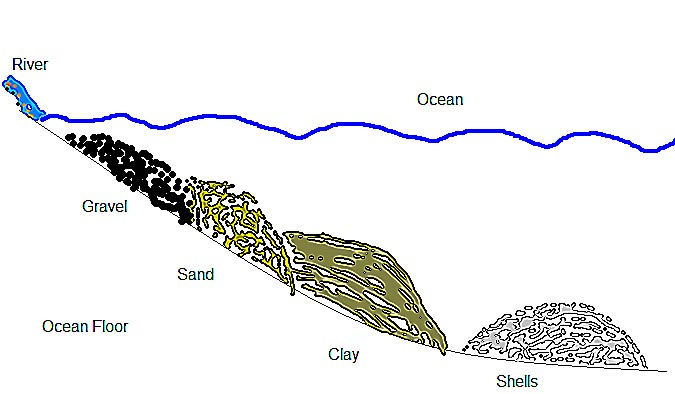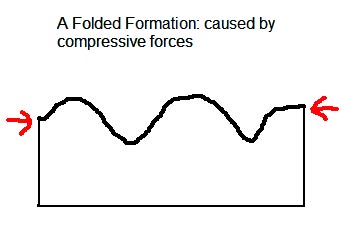Sedimentary
rocks
The first step that creates sedimentary rocks is when tectonic forces push rock formations upward to produce mountains. Since this rock formation is know exposed to the surface conditions, it becomes eroded and weathered. These effects cause the rock to wear down. Due to deposition, sorting of various fragments occurs. Think of a stream that flows down a mountain. Within this stream there are many different materials that travel due to the velocity of the stream. Depending on how much distance is traveled by the river in a specific time defines its velocity.
V=(change in distance)/(change in time)
If the velocity is fast enough, it is able to budge big rocks as well as small rocks down the terrain. Eventually the slope becomes less and less steep, which causes the velocity of the stream to decrease. Since the velocity of the stream becomes slower as it arrives to a flat surface, it is not able to sustain a fast enough of a speed to make the heavier materials to continue with the journey. Usually at the bottom of this river, it will empty into a big body of water like the ocean.
The first step that creates sedimentary rocks is when tectonic forces push rock formations upward to produce mountains. Since this rock formation is know exposed to the surface conditions, it becomes eroded and weathered. These effects cause the rock to wear down. Due to deposition, sorting of various fragments occurs. Think of a stream that flows down a mountain. Within this stream there are many different materials that travel due to the velocity of the stream. Depending on how much distance is traveled by the river in a specific time defines its velocity.
V=(change in distance)/(change in time)
If the velocity is fast enough, it is able to budge big rocks as well as small rocks down the terrain. Eventually the slope becomes less and less steep, which causes the velocity of the stream to decrease. Since the velocity of the stream becomes slower as it arrives to a flat surface, it is not able to sustain a fast enough of a speed to make the heavier materials to continue with the journey. Usually at the bottom of this river, it will empty into a big body of water like the ocean.

Notice from the picture above how the different fragments are all submerged, yet divide into different groups. The reason for this is that there is still a river velocity that causes movement in the various fragments farther down the ocean floor. The picture below shows how this might look years later once the river has dried out. Notice the big rocks are protruding from the water. This is either from corrosion to the rock formation next to the ocean or it is due to the rocks that came from a high velocity mountain stream.

After all of these fragments arrange in their groups,
lithification occurs. Lithification is the “conversion of
unconsolidated sediments into sedimentary rock by
compaction and cementation”(1).
This compaction and cementation yields these
sedimentary rocks:
-Gravel turns into conglomerate
-Sand turns into sandstone
-Clay turns into shale
-Shells turn into limestone
[e]
Over a long period of time, many different layers of sedimentary rock are developed due to the migration of water.
Rock Distortion
The geological distortion of the rock formations occurs afterward due to the various earth forces. Folding and faulting are two of the more important distortions to oil developers. Folding occurs when the compressive force of plate movement causes the crust to buckle into folds that are “perpendicular to the direction of movement”(1). This is much like the outcome of walking on a carpet that is not secure on one side. The person that walks on it will cause it to bunch up in certain areas. There are two structural features of a folded formation. The top of the fold is called an anticline and the bottom of the fold is called a syncline. Anticlines are especially an interest to oil developers because they provide a trap, which is discussed later on this site. Faults are geological structures that can be caused by compression forces in the crust, tension forces in the crust or shear forces in the crust. A fault is characterized by slippage along a fracture plane. (In the illustration, the shear fault is three dimensional, therefore the circle with the dot signifies the force is pointing out of the screen while the circle with the x signifies the force going into the screen.)

